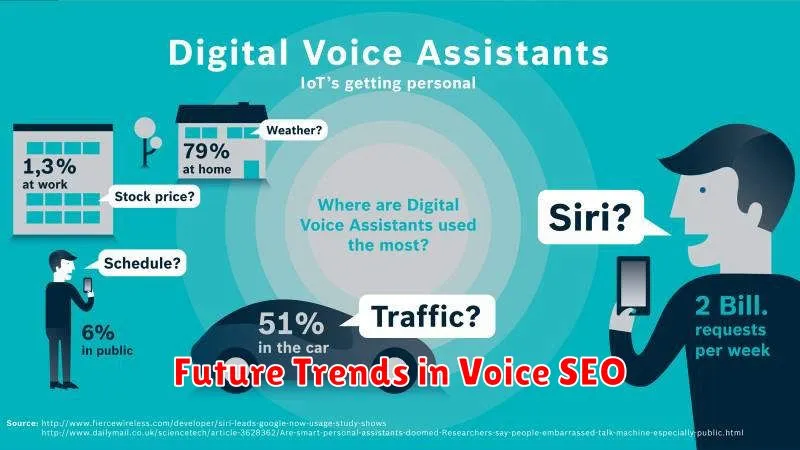In today’s rapidly evolving digital landscape, voice search optimization has become a crucial aspect of any successful digital marketing strategy. With the increasing prevalence of voice-activated devices like smartphones, smart speakers, and virtual assistants, consumers are shifting their search habits from typing to speaking. This shift presents both a challenge and an opportunity for digital marketers. Understanding how voice search works and optimizing your online presence for it is essential to stay ahead of the curve and connect with your target audience effectively. This article will explore the key elements of voice search optimization for digital marketers and provide actionable insights to enhance your voice search strategy.
Voice search optimization differs significantly from traditional text-based search engine optimization. Users employ more conversational and longer-tail keywords when engaging in voice search. They ask questions rather than typing in short keyword phrases. This necessitates a shift in keyword research and content creation strategies. As a digital marketer, you need to understand the nuances of voice search queries to optimize your website content, local SEO, and overall online presence for this growing trend. By implementing the strategies outlined in this article, you can effectively capture the attention of voice search users and drive valuable traffic to your business.
What Is Voice Search and Why It Matters
Voice search is a technology that allows users to search the internet using spoken language instead of typing keywords. Using voice-activated assistants like Siri, Alexa, or Google Assistant, users can ask questions, issue commands, and seek information naturally and conversationally. This technology leverages speech recognition to translate spoken words into text and natural language processing (NLP) to understand the intent behind the query. This provides a hands-free and convenient way to access information, especially while multitasking or on the go.
The increasing prominence of voice search matters significantly for businesses and content creators. As more people adopt this technology, optimizing content for voice search becomes crucial. Unlike traditional typed searches which often focus on short keywords, voice searches tend to be longer and more conversational. This shift requires adapting content strategies to incorporate long-tail keywords and natural language phrases. Furthermore, providing clear and concise answers to anticipated questions is vital to rank highly in voice search results. Failing to adapt to this evolving search landscape can lead to decreased visibility and missed opportunities to connect with potential customers.
The impact of voice search extends beyond just search engine optimization. It’s transforming how users interact with technology and access information, ultimately impacting website design, customer service, and overall user experience. Businesses that adapt their strategies to cater to this growing trend are better positioned to connect with their audience in a more natural and intuitive way, building stronger engagement and fostering customer loyalty.
How Voice Queries Differ from Text
Voice search queries tend to be longer and more conversational than text-based searches. Instead of short keyword phrases like “best Italian restaurant NYC,” a voice search might be phrased as “OK Google, what’s the highest-rated Italian restaurant near me that’s open now?” This conversational style reflects how we naturally speak and necessitates that businesses optimize their online presence for longer-tail keywords and natural language phrasing. Understanding this fundamental difference is crucial for adapting SEO strategies and content creation.
Another key difference lies in the intent behind the search. Text searches are often informational, seeking specific facts or data. Voice searches, on the other hand, frequently carry a transactional intent. Users are often looking to complete an action, such as making a reservation, getting directions, or purchasing a product. This means businesses need to structure their content to facilitate these actions, perhaps by incorporating clear call-to-actions and optimizing for local search results.
Finally, the context surrounding voice search is usually different. While text searches are often performed on a desktop or laptop, voice searches are frequently conducted on mobile devices while users are on the go. This means businesses must ensure their websites are mobile-friendly and provide quick, relevant information tailored to the user’s immediate needs and location. This includes optimizing for local SEO and ensuring fast page load times.
Targeting Conversational Keywords
Conversational keywords are search queries phrased as questions or natural language statements, reflecting how people speak in everyday conversations. These keywords are longer and more specific than traditional keywords, often including question words like “what,” “how,” “why,” “where,” and “who.” Targeting these keywords allows businesses to connect with users at a point where they are actively seeking information or solutions, leading to higher engagement and conversion rates. This approach aligns with the increasing prevalence of voice search and the desire for more personalized online experiences.
Implementing a conversational keyword strategy involves thorough keyword research. Tools like answerthepublic.com can provide valuable insights into the questions people are asking related to your industry. Analyzing search query reports and utilizing Google’s “People also ask” feature can further refine your understanding of user intent. Once identified, these conversational keywords should be integrated naturally within your website content, particularly in blog posts, FAQs, and product descriptions. Focusing on providing clear, concise answers to user queries is crucial.
The benefits of targeting conversational keywords extend beyond increased traffic. By addressing specific user questions, businesses can establish themselves as authoritative sources within their niche. This builds trust and credibility, fostering stronger relationships with potential customers. Furthermore, conversational content often aligns well with featured snippets and voice search results, leading to enhanced visibility and greater brand awareness. Ultimately, a conversational keyword strategy caters to the evolving search landscape and positions businesses to effectively connect with their target audience.
Creating FAQ-Style Content

FAQ content aims to provide concise and relevant answers to commonly asked questions. Focusing on clarity is crucial. Begin by identifying the most frequent inquiries related to your product, service, or topic. Then, formulate clear, easy-to-understand answers that directly address the question. Avoid jargon and technical terms whenever possible, opting for simple language that everyone can comprehend.
Structuring your FAQ section effectively improves readability and user experience. Organize questions logically, grouping similar topics together. Use clear headings and bullet points where appropriate to enhance navigation and make it easy for users to find the information they need. Keep answers brief and focused, providing sufficient detail without becoming overly verbose. A well-structured FAQ section can significantly reduce support inquiries and improve customer satisfaction.
Regularly reviewing and updating your FAQ content is essential. As your product or service evolves, new questions will inevitably arise, and existing answers may become outdated. By actively monitoring user inquiries and feedback, you can identify areas where your FAQ section can be improved. Keeping your content current and accurate ensures that it remains a valuable resource for users and helps maintain a positive user experience.
Optimizing for Featured Snippets
Featured snippets are the coveted position zero in search results, appearing above even the top organic ranking. They provide a concise answer to a user’s query directly on the search results page. Optimizing for featured snippets requires understanding user intent and crafting content that directly and accurately addresses it. Focusing on question-based keywords and providing clear, concise answers is essential. Structuring your content with headings, lists, and tables can also improve your chances of securing a featured snippet.
To increase your chances of earning a featured snippet, conduct thorough keyword research to identify questions relevant to your target audience. Once you’ve identified relevant questions, tailor your content to provide the most direct and comprehensive answer possible. Consider using the question as a heading and then providing a succinct answer immediately following. Content length is also a factor, as featured snippets tend to favor shorter, easily digestible answers.
Finally, regularly monitor your performance in search results. Track which keywords are triggering featured snippets and analyze the content that’s currently ranking. This competitive analysis can provide valuable insights into what’s working and allow you to adjust your strategy accordingly. By continuously optimizing your content and staying informed about search trends, you can improve your chances of securing these highly valuable featured snippets.
Page Speed and Mobile Experience
Page speed is a crucial factor in user experience and search engine optimization (SEO). A fast-loading website provides a better user experience, leading to increased engagement, conversions, and customer satisfaction. Slow loading times, on the other hand, can lead to high bounce rates and lost revenue. Factors affecting page speed include image size, server response time, and the complexity of the website’s code.
Mobile experience is equally important, considering the significant portion of internet traffic that originates from mobile devices. A website must be responsive and adapt to various screen sizes. This includes easy navigation, readable text, and quick-loading content optimized for mobile connections. Google considers mobile-friendliness as a ranking factor, highlighting its importance for online visibility.
Optimizing both page speed and mobile experience are essential for a successful online presence. By prioritizing these factors, businesses can improve user engagement, increase conversions, and enhance their search engine rankings.
Schema Markup for Voice Assistants
Schema markup is essential for helping voice assistants understand the content on your website. It provides context and meaning to your data, allowing assistants to accurately interpret information and deliver relevant results to users. Think of it as a translator between your website and the voice assistant, clarifying what your content is about and how it should be understood. This leads to richer, more accurate responses to voice searches and can significantly improve your site’s visibility in voice search results.
By implementing schema, you can provide explicit clues about your business, including your name, address, phone number, hours of operation, and even customer reviews. For product pages, you can specify details like price, availability, and ratings. This structured data enables voice assistants to answer user queries directly with information pulled from your schema markup, improving the user experience and increasing the likelihood of conversions.
While not mandatory, using schema markup is highly recommended for optimizing your website for voice search. By providing structured data, you’re effectively giving voice assistants the information they need to understand and present your content in the best possible way. This can lead to increased traffic, improved brand visibility, and a better overall experience for users interacting with your website through voice search.
Tracking Voice Search Metrics
Tracking voice search metrics requires a slightly different approach than traditional typed searches. While some standard metrics like conversion rate and bounce rate still apply, you also need to consider voice-specific data. This includes understanding utterances (what people actually say into their devices), intent (what they’re trying to achieve), and fulfillment (whether the voice assistant successfully answered the query). Analyzing these metrics can reveal how people phrase voice searches, allowing you to optimize content for natural language and conversational queries.
Tools like Google Search Console and analytics platforms can help track voice search performance. Look for increases in long-tail keywords and question-based queries, which are common in voice search. Also, pay attention to the device type used for the search (smart speaker, smartphone, etc.) as this can influence user behavior and intent. By monitoring these metrics, you can gain valuable insights into how people are using voice search to find your website or content.
Optimizing for voice search is crucial for staying visible in the evolving search landscape. Focusing on providing concise answers, using structured data, and claiming your Google Business Profile can significantly improve your voice search rankings. Remember, voice search is all about providing quick, relevant, and conversational responses to user queries.
Industries Most Affected by Voice
Voice technology is rapidly transforming how businesses interact with customers and conduct operations. Several industries are at the forefront of this change, experiencing both disruption and opportunity. Customer service is one area being heavily impacted, with voice assistants handling basic inquiries and freeing up human agents for more complex issues. E-commerce is another key area, as voice shopping allows for hands-free browsing and purchasing. Additionally, the healthcare industry is seeing growth in voice-enabled applications for patient monitoring, appointment scheduling, and medication reminders.
Other industries experiencing significant impact from voice technology include automotive, with voice commands becoming increasingly integrated into vehicle infotainment systems, and the smart home sector, where voice assistants control lighting, appliances, and security features. Entertainment and media consumption is also shifting towards voice-activated devices for accessing music, podcasts, and news. These industries are embracing voice to enhance customer experience, streamline processes, and create new revenue streams.
While these represent some of the most prominently affected industries, the reach of voice technology continues to expand. As the technology improves and adoption grows, we can expect to see even more sectors leverage the power of voice in the years to come. This includes industries like education, finance, and even manufacturing where voice can play a role in training, transactions, and operational efficiency.
Future Trends in Voice SEO

Voice search is rapidly evolving, and staying ahead requires understanding emerging trends. One key trend is the rise of conversational AI. Search engines are becoming more sophisticated at understanding natural language, allowing for more complex and nuanced voice queries. This means optimizing for long-tail keywords and question-based searches will become increasingly critical. Additionally, expect to see a greater emphasis on local SEO for voice search. As users increasingly rely on voice assistants for on-the-go searches, businesses need to ensure their local listings are accurate and optimized for voice queries related to location, hours, and services.
Another significant trend is the growing importance of user experience. Voice search users expect quick, accurate answers. This means website speed and mobile-friendliness are paramount. Content needs to be structured clearly and concisely, with an emphasis on providing direct answers to common questions. Furthermore, schema markup will play a more prominent role in voice SEO. Schema helps search engines understand the context of your content, making it easier to deliver relevant results to voice search users. This allows search engines to provide more targeted and relevant responses directly within the search results, which is essential for a positive voice search experience. Focus on optimizing for featured snippets and rich results to enhance visibility in voice search.
Finally, the integration of voice search with other technologies, such as smart home devices and wearables, will shape the future of voice SEO. As these devices become more ubiquitous, optimizing for voice commands and actions within these ecosystems will become essential. This will create new opportunities for businesses to connect with their target audiences in more seamless and personalized ways. Consider the different contexts in which users might utilize voice search and tailor your SEO strategy accordingly.

